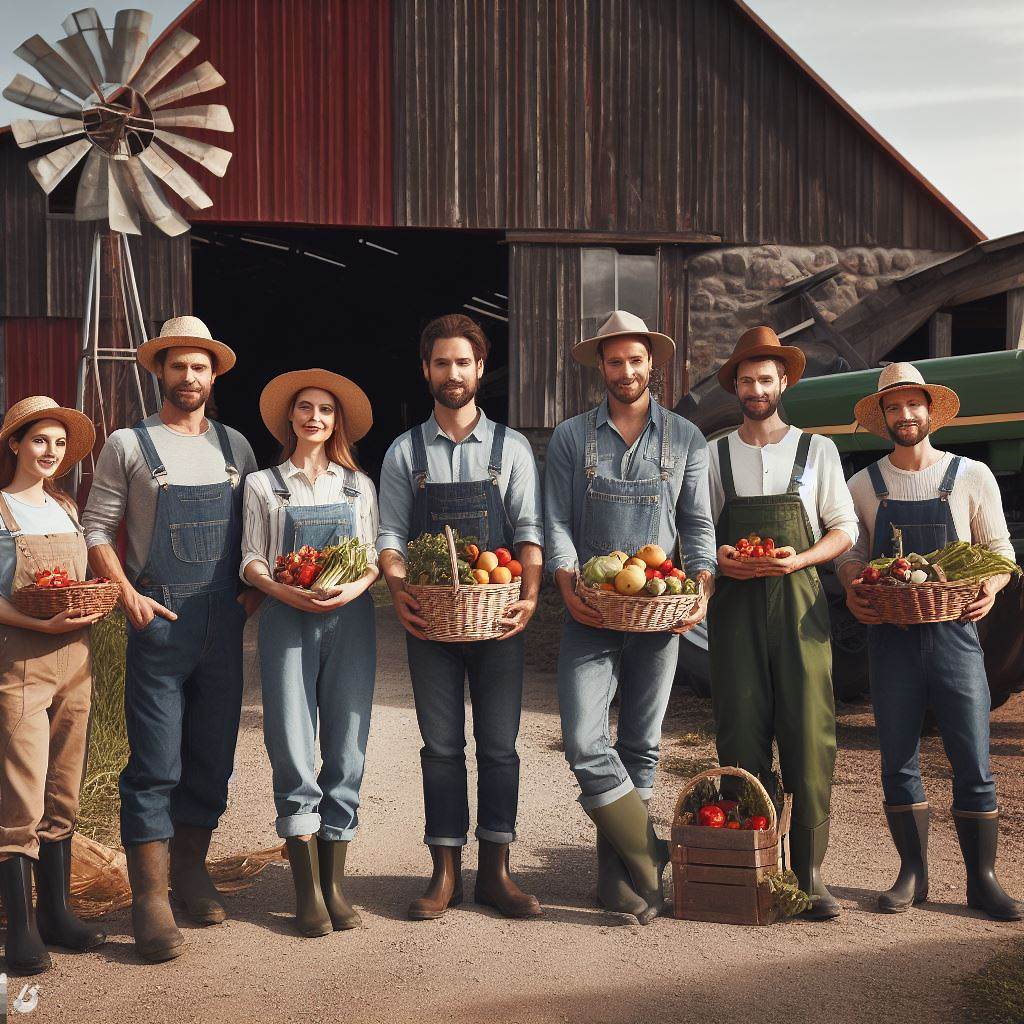Farm-to-Table: Growing Your Own Food
Last Updated on November 19, 2023
Introduction
Definition of Farm-to-Table
Farm-to-table refers to the practice of growing and consuming fresh food directly from the source, typically a local farm or garden.
Importance of growing own food
Growing your own food offers numerous benefits, including improved nutrition, cost savings, and reduced environmental impact.
Thesis statement – Benefits and steps to grow your own food
Growing your own food not only provides health benefits but also allows you to have control over the quality and diversity of your food.
By following a few simple steps, anyone can start their journey towards self-sustainability and reap the rewards of farm-to-table living.
Benefits of growing your own food
Growing your own food ensures that you have access to fresh and nutritious produce, free from harmful chemicals and pesticides.
Additionally, it promotes a healthier approach to eating by increasing the consumption of fruits and vegetables.
Steps to grow your own food
- Planning: Decide what crops to grow based on your climate, available space, and personal preferences.
Consider creating a garden layout to optimize productivity. - Preparation: Prepare the soil by removing weeds and debris, loosening it, and adding organic matter like compost.
This creates a fertile environment for plants to thrive. - Planting: Select high-quality seeds or seedlings and plant them at the appropriate time.
Follow planting instructions regarding spacing, depth, and watering requirements. - Maintenance: Regularly water, weed, and mulch your garden to ensure plants receive adequate moisture and nutrients.
Monitor for pests and diseases and take necessary actions to protect your crops. - Harvesting: Harvest crops when they are ripe and ready.
Enjoy the satisfaction of picking your own produce and savor the freshness in your meals. - Preservation: Preserve surplus produce through methods such as canning, freezing, or drying.
This allows you to enjoy your homegrown food throughout the year.
Growing your own food through the farm-to-table approach offers numerous benefits, from improved health and reduced environmental impact to increased self-sustainability.
By following the steps outlined above, you can embark on a rewarding journey towards a healthier and more sustainable lifestyle.
Benefits of Growing Your Own Food
Freshness and quality of produce
- When you grow your own food, you have the advantage of picking it fresh from your garden.
- This means that you can enjoy fruits and vegetables at their peak ripeness and flavor.
- Produce from your garden is not subjected to long transportation times or storage, ensuring its freshness.
- You have control over how the crops are harvested, allowing you to pick them at the perfect time for maximum flavor.
Control over pesticides and chemicals
- By growing your own food, you have complete control over what goes into it.
- You can choose to use organic farming methods, avoiding the use of harmful pesticides and chemicals.
- Being able to grow your own food without the need for synthetic inputs ensures healthier and safer produce.
- You can also experiment with natural pest control methods, such as companion planting, to protect your crops.
Cost savings
- Growing your own food can be a cost-effective way to supplement your grocery shopping.
- You can save money on buying expensive organic produce by growing it yourself.
- Seeds and starter plants are relatively inexpensive, especially when compared to the rising prices of fresh produce.
- By growing your own food, you can also reduce the frequency and amount of grocery purchases.
Enhanced nutritional value
- Homegrown produce is usually much more nutritious compared to store-bought produce.
- As soon as fruits and vegetables are harvested, their nutrient content starts to decline.
- When you grow your own food, you can enjoy it at its peak nutritional value.
- You have the option to choose nutrient-rich varieties and can be assured of their freshness.
Reduction of carbon footprint
- By growing your own food, you contribute to reducing your carbon footprint.
- Transportation and refrigeration of produce consume a significant amount of energy and emit greenhouse gases.
- When you grow your own food, you eliminate or reduce the need for such energy-intensive processes.
- By relying on your own garden, you can significantly reduce the carbon emissions associated with food production and distribution.
Growing your own food not only provides numerous benefits for you and your family but also for the environment.
It allows you to have control over the quality, freshness, and safety of your produce.
Additionally, cultivating your own food promotes sustainability by reducing the use of harmful chemicals and minimizing the carbon emissions associated with food production.
So, grab some seeds, find a sunny spot in your yard, and start enjoying the bountiful rewards of growing your own food!
Read: Greenhouse Gardening in Urban Spaces
Getting Started with Growing Your Own Food
Evaluating available space
- Measure and assess your outdoor or indoor space to determine the available area for planting.
- Consider factors such as sunlight exposure, drainage, and overall accessibility when evaluating your space.
- Determine if you have enough space for a garden bed, containers, or vertical gardening options.
- Take into account any existing structures or limitations that may affect your gardening space options.
Identifying suitable crops
- Research and identify suitable crops for your specific growing conditions and desired outcomes.
- Take into consideration your region’s climate, soil type, and available resources such as water.
- Start with beginner-friendly crops like leafy greens, herbs, and tomatoes for a successful start.
- Consider the nutritional value, productivity, and taste preferences when selecting your crops.
- Experiment with different varieties to find the ones that thrive in your specific growing environment.
Obtaining necessary tools and supplies
- Make a list of essential gardening tools such as shovels, rakes, hoes, and hand trowels.
- Purchase or gather the necessary supplies, including soil, compost, containers, and seeds or seedlings.
- Consider investing in quality tools and supplies for long-term use and better gardening experience.
- Look for local gardening stores or online resources to find the tools and supplies you need.
Understanding local weather and climates
- Research your local weather patterns, including average temperatures, rainfall, and frost dates.
- Determine the appropriateness of certain crops based on your region’s climate conditions.
- Plan your planting and harvesting schedule according to the climate patterns and optimal growing seasons.
- Consider using protective measures like row covers or greenhouses for crops that require specific climate conditions.
Considering time and effort investment
- Evaluate the amount of time and effort you are willing to invest in maintaining your own food garden.
- Start small if you have limited time, opting for a few container plants or a small garden bed.
- Be realistic about the time commitment required for watering, weeding, and overall garden maintenance.
- Consider getting help from family members or hiring a gardener if you are short on time but still want to enjoy the benefits of growing your own food.
By following these steps, you can confidently get started with growing your own food.
Remember that gardening is a continuous learning experience, so don’t be afraid to make mistakes and adjust your approach as needed.
Embrace the joys of growing your own food and savor the delicious results of your hard work!
Read: Heirloom vs. Hybrid: What’s Best for You?

Preparing the Soil
Choosing the right location for a garden
When selecting a location for your garden, consider factors like sunlight, accessibility, and proximity to a water source.
Clearing and leveling the ground
Before starting your garden, ensure that the ground is cleared of any debris or unwanted vegetation.
Level the area to create a smooth surface.
Testing soil quality
Conduct a soil test to determine its pH level and nutrient content.
This will help you understand the adjustments required for optimal plant growth.
Adding organic matter and nutrients
Enrich the soil by incorporating compost, aged manure, or organic fertilizers to improve its fertility and provide essential nutrients for plants.
Proper soil drainage techniques
Avoid waterlogged or poorly drained soil; use raised beds, organic amendments, or drainage channels.
Prepare the soil for a successful farm-to-table garden, creating a nourishing environment for thriving plants.
Select a sunny location, ideally six to eight hours, ensuring energy for crop growth.
Consider accessibility for easy watering, weeding, and harvesting; proximity to a water source minimizes irrigation effort.
Clear the area of debris, level the ground for effective irrigation, and test soil quality for pH and nutrients.
Incorporate organic matter like compost to improve fertility and provide essential nutrients for flourishing plants.
Ensure proper drainage with raised beds or organic amendments like perlite; create channels to divert excess water.
Maintain a moisture balance, preventing waterlogged soil while ensuring plants receive sufficient hydration.
Regularly monitor soil moisture levels, adjusting irrigation for optimal plant growth.
In summary, preparing the soil is vital for a successful farm-to-table experience.
Choose the right location, clear and level the ground, test and amend soil, and implement proper drainage techniques for a thriving garden.
Invest time and effort for a bountiful, sustainable harvest.
Read: Herbs & Spices: Growing Your Flavor Garden
Selecting and Planting the Crops
Researching Crop Preferences and Requirements
- Understand the preferences and requirements of the crops you want to grow.
- Research their specific growing conditions, such as sunlight, soil type, and water needs.
- Consider the climate of your region to ensure the crops will thrive in your area.
- Look for crop varieties that are well-suited to your local climate and soil conditions.
Planning the Garden Layout and Design
- Create a detailed plan for your garden, considering the available space and your crop preferences.
- Decide on the layout of beds, paths, and other features to optimize space utilization and accessibility.
- Consider companion planting techniques to maximize the benefits of growing different crops together.
- Make sure to leave enough space between beds for ease of movement and maintenance.
Starting with Small and Easy-to-Grow Crops
- If you are a beginner, start with small and easy-to-grow crops to gain experience and confidence.
- Leafy greens like lettuce, spinach, and kale, as well as herbs like basil and parsley, are good choices.
- These crops have relatively short growing seasons and require minimal maintenance.
- Growing small crops first will allow you to learn and refine your gardening skills.
Planting Seeds or Seedlings with Care
- Carefully follow the instructions on the seed packets or plant labels when planting seeds or seedlings.
- Determine the appropriate planting depth and spacing for each crop to ensure proper growth.
- Handle seedlings with care, gently transplanting them into the prepared soil or containers.
- Water the newly planted crops thoroughly and provide any necessary support or protection.
Maintaining Proper Spacing and Companion Planting Techniques
- Regularly monitor the growth of your crops and ensure they are not overcrowded.
- Thin out the seedlings if they are too close together, following the recommended spacing guidelines.
- Practice companion planting by growing compatible crops together to enhance pest control and nutrient absorption.
- Avoid planting crops from the same family in close proximity, as they may compete for resources.
In essence, selecting and planting crops in your farm-to-table garden requires careful research, planning, and maintenance.
By understanding the preferences and requirements of your chosen crops, designing an efficient garden layout, starting with easy-to-grow varieties, and planting with care, you can ensure a successful harvest.
Maintaining proper spacing and practicing companion planting techniques further optimize the growth and health of your crops.
With dedication and knowledge, you can enjoy the satisfaction of growing your own food.
Read: Vertical Gardening: Maximize Your Yield
Caring for Your Plants
When it comes to growing your own food, caring for your plants is crucial for a successful and fruitful harvest.
By implementing the right practices, you can ensure the health and well-being of your plants.
In this section, we will discuss several important aspects of plant care.
Regular watering schedules
Watering your plants properly is essential for their growth and development.
Establish a regular watering schedule, making sure to water deeply to encourage deep root growth.
Be mindful not to overwater, as it can lead to root rot and other issues.
Implementing organic pest control methods
In order to protect your plants from pests, it is important to use organic pest control methods.
Consider using companion planting, which involves growing certain plants together to repel pests, or using insect-repelling organic sprays and traps.
Weed management and prevention
Weeds can compete with your plants for nutrients, water, and sunlight.
Regularly remove weeds from your garden to prevent them from hindering the growth of your plants.
Mulching can also help to suppress weeds and retain moisture in the soil.
Providing adequate sunlight and shade
Different plants have different sunlight requirements.
Before planting, research the sunlight needs of your specific plants and ensure that they are placed in an appropriate location in your garden.
Additionally, consider providing shade for sun-sensitive plants during the hottest parts of the day.
Understanding and addressing plant diseases and nutrient deficiencies
Keep a close eye on your plants for any signs of disease or nutrient deficiencies.
Learn to identify common plant diseases and take prompt action to address them with organic treatments.
Regularly monitor your soil’s nutrient levels and adjust fertilization accordingly.
Caring for your plants is an ongoing process that requires attention and dedication.
By following these practices, you can maximize the health and productivity of your plants, ultimately leading to a bountiful harvest of homegrown, organic food.
Harvesting and Preserving Your Produce
Recognizing signs of ripeness and readiness
- Look for vibrant color, firmness, and sweet fragrance to determine if fruits and vegetables are ripe.
- Check if the crops have reached their desired size and shape, indicating their readiness for harvesting.
- Take note of the maturity date specified for each plant variety to ensure optimal flavor and texture.
Proper harvesting techniques
- Use sharp and clean gardening tools to avoid any damage to the crops while harvesting.
- Harvest leafy greens and herbs by picking the outer leaves or cutting them about an inch above the ground.
- For root vegetables, gently tug them out of the soil or use a digging fork to avoid breaking or bruising.
- Handle delicate produce, such as berries and tomatoes, with care to prevent any mishandling that may cause spoilage.
Storing and preserving harvested produce
- Store most produce in a cool, dry, and well-ventilated area to maintain freshness and extend shelf life.
- Keep fruits and vegetables with different temperature and humidity requirements separate to prevent spoilage.
- Use breathable containers, like paper bags or mesh bags, to store vegetables like potatoes and onions.
- Consider using a root cellar or cellar-like environment for longer storage of root vegetables and winter squashes.
Freezing, canning, and drying methods
- Freezing is ideal for preserving fruits, vegetables, and herbs while maintaining their nutrient content.
- Canning is a popular method for preserving produce, especially for making jams, jellies, and pickles.
- Drying, either through air drying or using a dehydrator, is a great way to preserve herbs, fruits, and vegetables.
- Follow proper procedures and guidelines to ensure food safety while using these preservation methods.
Sharing excess harvest with neighbors or local communities
- Consider creating a neighborhood or community sharing program to distribute surplus produce.
- Connect with local food banks, shelters, or community organizations to donate your excess harvest.
- Organize a neighborhood swap event where neighbors can exchange their excess produce with each other.
- Sharing your bounty not only helps reduce food waste but also fosters a sense of community.
Conclusion
Growing your own food not only provides numerous health benefits but also saves money and promotes self-sufficiency.
Start your farm-to-table journey today and experience the joy of harvesting your own fresh produce.
Embracing sustainable living and taking small steps towards self-sufficiency can positively impact our planet and future generations.
So go ahead, grow your own food and make a difference!
Embarking on the farm-to-table journey empowers you to savor the fruits of your labor.
Cultivating your food offers unparalleled freshness and nutritional value.
Take joy in the connection to the earth, witnessing the transformation from seed to plate.
Your homegrown produce embodies sustainability and reduces your environmental footprint.
The journey from soil to table fosters a profound appreciation for the food cycle.
Growing your own food becomes a fulfilling, rewarding lifestyle, promoting self-sufficiency and well-being.
Embrace the therapeutic benefits of nurturing your garden, fostering a deeper understanding of the food you consume.
With each harvest, relish the flavors of success and the satisfaction of contributing to a healthier, eco-conscious lifestyle.
As you indulge in the delicious results, know that your farm-to-table adventure is not just a practice but a transformative journey towards a more sustainable and fulfilling way of living.
Happy harvesting!


